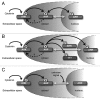Localization of the Arabidopsis histidine phosphotransfer proteins is independent of cytokinin
- PMID: 20484973
- PMCID: PMC3115040
- DOI: 10.4161/psb.5.7.12094
Localization of the Arabidopsis histidine phosphotransfer proteins is independent of cytokinin
Abstract
Cytokinins are a class of mitogenic plant hormones that influence shoot and root growth, vascular and photomorphogenic development, leaf senescence, and many other aspects of plant growth and development. The Arabidopsis histidine phosphotransfer proteins (AHPs) play an important role in cytokinin signaling by bridging the perception of cytokinins by plasma-membrane receptors to the activation of cytokinin-responsive transcription factors. Based on previous microscopic observations, a model was developed in which the AHPs were thought to relocalize from the cytosol into the nucleus in response to exogenous cytokinin. However, analysis and quantification of the intracellular distribution of AHPs in both protoplasts and intact transgenic plants revealed that the subcellular localization of the AHPs is persistently nucleo-cytosolic and non-responsive to the state of the cytokinin response pathway. Here, we review and extend these findings and discuss their implications.
Figures


Comment on
-
The subcellular distribution of the Arabidopsis histidine phosphotransfer proteins is independent of cytokinin signaling.Plant J. 2010 May;62(3):473-82. doi: 10.1111/j.1365-313X.2010.04165.x. Epub 2010 Feb 3. Plant J. 2010. PMID: 20136728
Similar articles
-
The subcellular distribution of the Arabidopsis histidine phosphotransfer proteins is independent of cytokinin signaling.Plant J. 2010 May;62(3):473-82. doi: 10.1111/j.1365-313X.2010.04165.x. Epub 2010 Feb 3. Plant J. 2010. PMID: 20136728
-
The Arabidopsis histidine phosphotransfer proteins are redundant positive regulators of cytokinin signaling.Plant Cell. 2006 Nov;18(11):3073-87. doi: 10.1105/tpc.106.045674. Epub 2006 Nov 22. Plant Cell. 2006. PMID: 17122069 Free PMC article.
-
Arabidopsis cytokinin signaling pathway.Sci STKE. 2007 Oct 9;2007(407):cm5. doi: 10.1126/stke.4072007cm5. Sci STKE. 2007. PMID: 17925576 Review.
-
Two-component circuitry in Arabidopsis cytokinin signal transduction.Nature. 2001 Sep 27;413(6854):383-9. doi: 10.1038/35096500. Nature. 2001. PMID: 11574878
-
Cytokinin signal transduction in plant cells.J Plant Res. 2003 Jun;116(3):221-31. doi: 10.1007/s10265-003-0094-6. Epub 2003 Apr 17. J Plant Res. 2003. PMID: 12836044 Review.
Cited by
-
The yin-yang of hormones: cytokinin and auxin interactions in plant development.Plant Cell. 2015 Jan;27(1):44-63. doi: 10.1105/tpc.114.133595. Epub 2015 Jan 20. Plant Cell. 2015. PMID: 25604447 Free PMC article. Review.
-
Evidence for Functionality of Transmembrane Domains of Predicted Non-Canonical Plant Phosphotransmitters.Dokl Biochem Biophys. 2025 Jun 2. doi: 10.1134/S1607672925600381. Online ahead of print. Dokl Biochem Biophys. 2025. PMID: 40459828
-
Arabidopsis response Regulator1 and Arabidopsis histidine phosphotransfer Protein2 (AHP2), AHP3, and AHP5 function in cold signaling.Plant Physiol. 2013 Jan;161(1):408-24. doi: 10.1104/pp.112.207621. Epub 2012 Nov 2. Plant Physiol. 2013. PMID: 23124324 Free PMC article.
-
The Interaction Network and Signaling Specificity of Two-Component System in Arabidopsis.Int J Mol Sci. 2020 Jul 11;21(14):4898. doi: 10.3390/ijms21144898. Int J Mol Sci. 2020. PMID: 32664520 Free PMC article. Review.
-
Arabidopsis CKI1 mediated two-component signaling in the specification of female gametophyte.Plant Signal Behav. 2018;13(10):e1469360. doi: 10.1080/15592324.2018.1469360. Epub 2018 Aug 27. Plant Signal Behav. 2018. PMID: 30148413 Free PMC article.
References
-
- Perilli S, Moubayidin L, Sabatini S. The molecular basis of cytokinin function. Curr Opin Plant Biol. 13:21–26. - PubMed
-
- To JPC, Kieber JJ. Cytokinin signaling: two-components and more. Trends Plant Sci. 13:85–92. - PubMed
-
- Müller B, Sheen J. Advances in cytokinin signaling. Science. 318:68–69. - PubMed
-
- Parkinson J. Signal transuction schemes of bacteria. Cell. 73:857–871. - PubMed
-
- Stock AM, Robinson VL, Goudreau PN. Two-component signal transduction. Annu Rev Biochem. 69:183–215. - PubMed
Publication types
LinkOut - more resources
Full Text Sources
Molecular Biology Databases
